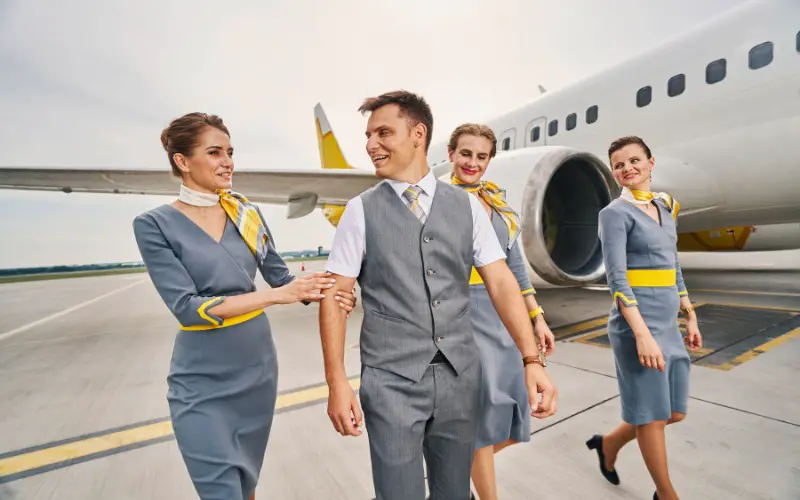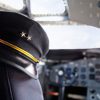There are different factors that determine how many flight attendants are working on a flight.
Most government regulators determine the minimum crew members required for safety that respective carriers must comply by and then the airlines determine how many more are necessary to carry out their service standards.
Let’s take a look at some of the government regulations and airline guidelines on staffing an aircraft.
💡 Key Takeaways
- For every 50 passengers, there must be at least one flight attendant.
- In the case of wide body aircrafts with double aisles, each emergency exit must be staffed by a flight attendant.
- If the duty day of a flight attendant is scheduled to exceed 14 hours, additional flight attendants need to be staffed.
- Airlines also consider their operational costs when determining the number of flight attendants.
Why Is There a Minimum Number of Cabin Crew Required?
There is a famous saying in the aviation industry… “Aviation regulations are written in blood.”
It sounds too appalling to fathom, but it is unfortunately true.
Many of the aviation regulations we currently have came about from learning from previous tragic events.
For example, pilots adhere to strict work and rest requirements because many tragic events were attributed to their fatigue on the job.
Or why do flight attendants require purses and bags to be stowed under the seat in front of you? Because it’s been shown that the straps on the bags get caught on the armrest, interfering with other passengers evacuating the aircraft in an emergency.
The minimum number of flight attendants for different aircrafts has also been established to best prepare for both foreseeable and unforeseeable emergencies that can happen at any time.
Government Regulations
Government regulations that affect the number of cabin crew required:
In the US, the aviation industry is regulated by the FAA (Federal Aviation Administration) and in Europe by EASA the (European Aviation Safety Agency).
The regulations regarding minimum crew for different aircrafts is similar for both regulating bodies.
First, for every 50 passengers on board, there must be one flight attendant.
For example, even though the standard Airbus 321-200 (A321) aircraft is operated by many different airlines, Delta Airlines’ A321 would have a minimum crew member of 4 because their airplanes are configured with 191 seats (less than 200) while Air France’s A321 would have a minimum crew of 5 because their aircrafts are configured to have 212 seats (more than 200 but less than 250).
Number of Emergency Exits
Second, the regulating bodies require airlines to staff each emergency exit on airplanes with double aisles (wide body aircrafts) with one flight attendant.
For example, even though United Airlines’ Boeing 777-300 (B777) are configured to have 350 seats, the minimum crew for this aircraft is still 10 flight attendants instead of 7 because it has 10 emergency exits.
Duty Length
Lastly, the minimum crew is determined by the duty length for the flight attendants.
By law, the airlines can schedule a flight attendant to work up to 14 hours.
For short haul flights, where multiple destinations are scheduled as part of the duty day, start time to end time has to be less than 14 hours.
If it exceeds 14 hours due to irregular operations such as weather or various delays, it could be extended depending on other factors and circumstances.
This doesn’t affect the minimum crew that are already working on an aircraft, but for long haul flights that are scheduled to exceed a 14-hour duty day, an additional flight attendant has to be staffed on board before operation.
For duty day that is scheduled to be over 14 hours but under 16 hours, at least one additional flight attendant has to be staffed above minimum crew (if it is the case for United Airlines B777, it has to be 11 flight attendants instead of 10).
And for duty day scheduled to be over 16 hours but under 18 hours, two additional flight attendants have to be staffed above minimum crew (12 flight attendants instead of 10).
Airline Service Standards
Unfortunately, most if not all decisions made by businesses, including airlines, are based heavily on one factor: their bottom line.
Businesses have to conduct a cost-benefit analysis in order to calculate their profit compared to their operational expenses to maximize their yield.
Because of this, American Airlines made headlines when they announced that they would be decreasing the number of flight attendants on board their A321 Transcontinental flights from 6 flight attendants to 5.
Now, this airplane is configured to have 10 first class seats, 20 business class seats, and 72 main cabin seats, with a single aisle and 8 emergency exits so the government minimum crew requirement is only 4 flight attendants.
However, this airplane serves a very premium route for American Airlines, mainly between Los Angeles and New York, so the in-flight service experience offered on this flight is quite over the top.
Though it is a domestic route, their Flagship First seats are personal cubicles with fully reclining seats and the passenger gets to enjoy a 5-course dining experience with an exclusive wine list.
The services and comfort offered for business class seats don’t fall too far behind first and this is the only flight that the airline offers meals that are included in a domestic flight (simple box sandwiches).
During the pandemic, the airline made the decision to cut operational costs by reducing the number of flight attendants working the flight (understandably so because service has been reduced to minimize contact and the aviation industry, in general, was losing a lot of money), but when the airline decided to bring back full pre-pandemic service yet maintain the reduced number of crew members, it received backlash from both flight attendants and passengers alike citing the inability to provide the same service as before.
The best scenario for passengers would be to reduce the passengers per flight attendant ratio so that more passengers could receive detailed attention from the flight attendants, but airlines also have to consider their operational costs.
Conclusion
As stated above, there are many different factors that contribute to how many flight attendants are required and staffed on an aircraft.
Government regulating bodies focus on the minimum required to ensure the safety of the passengers while airlines try to find the right balance between cost and service needs.
Regardless of how many flight attendants are in your flight, remember that there are many passengers per limited number of flight attendants so be kind to them and your fellow passengers.



